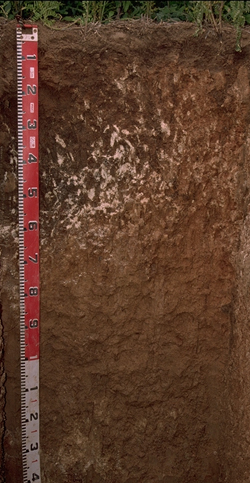Location: Gooroc
Australian Soil Classification: Endocalcareous-Endohypersodic, Self-Mulching, Red VERTOSOL
Northcote Factual Key: Ug 5.3
General Landscape Description: Level plain which originally displayed gilgai microrelief.

LP93a Landscape |
Soil Profile Morphology:
Surface Soil
| A1 | 0-10 cm | Dark brown (10YR3/3); light medium clay; self-mulching surface condition; firm consistence dry; pH 8.3; clear change to:
|  LP93a Profile LP93a Profile |
Subsoil
|
| B21 | 10-30 cm | Yellowish red (5YR5/8); medium heavy clay; moderate fine blocky, parting to moderate fine polyhedral structure; firm consistence dry; contains a few (8%) soft carbonates, very few (< 2%) carbonates (5-10 mm size) and very few (< 2%) ferromanganiferous nodules (3-5 mm size); pH 8.6:
|
| B22k | 30-70 cm | Yellowish red (5YR5/6); medium heavy clay; strong coarse prismatic, parting to strong coarse blocky structure; very firm consistence moderately moist; contains a common (10%) amount of soft carbonates; pH 9.3; clear change to:
|
| B23 | 70-90 cm | Reddish yellow (5YR6/6); medium clay; firm consistence moist; pH 9.5; gradual change to:
|
| B31 | 90-120 cm | Light brown (7.5YR6/4); light medium clay; strong fine polyhedral structure; pH 9.5. |
Key Profile Features:
.
- High clay content throughout soil profile.
- Vertic properties (i.e. significant shrink-swell characteristic).
|
Soil Profile Characteristics:
.
 | pH | Salinity Rating | | |
Surface
(A1 horizon) | moderately alkaline | very low | non-sodic | none |
Subsoil
(B21 horizon) | strongly alkaline | very low | non-sodic | none |
Deeper subsoil
(at 1 m) | very strongly alkaline | medium-high | strongly sodic | - |

Management Considerations:
Whole Profile
.
- Plant available water capacity (PAWC) is considered to be medium (estimated at 120 mm). This is based on available laboratory data and assumes an effective rooting depth of 90 cm. Rooting depth will be restricted by the increased level of soluble salts in the strongly sodic deeper subsoil.
|
Surface (A) Horizon
.
- The surface soil is self-mulching which provides a good seed bed that is friable and easily worked. The surface is non-sodic and has a very high level of exchangeable calcium, which will contribute to creating favourable surface soil structural conditions.
- The relatively high wilting point (i.e. 20%) indicates that plants will be unable to fully utilise light rains when the soil is relatively dry.
- Tillage of cracking clay soils should be avoided if the soil is wet (i.e. wetter than the plastic limit). At such moisture conditions, excessive tillage, trafficking or overstocking could result in structural damage (e.g. compaction, smearing) occurring. Ideally, tillage and trafficking should take place when the soil is drier than the plastic limit, down to at least the depth of tillage.
- The surface soil has a very high inherent fertility (based on the sum of the exchangeable basic cations).
- Crop performance may be quite variable across the paddock due to differences in soil properties associated with gilgai (mound and depression) microrelief.
|
Subsoil (B) Horizons
.
- The upper subsoil is non-sodic and does not disperse. Also, it has a high level of exchangeable calcium which has a stabilising effect on soil structure. The soil breaks down into fine polyhedral aggregates which allows relatively good water and plant root movement.
- The deeper subsoil becomes sodic and the level of exchangeable magnesium increases with depth. Root and water movement will therefore be more restricted at depth.
- The subsoil is strongly alkaline, which indicates that some nutrients (e.g. iron, manganese, copper, zinc) may be poorly available to plants. Deficiencies can be assessed by plant tissue analysis.
- The level of soluble salts becomes medium-high in the deeper subsoil (from approximately 90 cm depth and is only likely to restrict the growth of deeper rooted salt sensitive species.
|
Comments from Landholder:
.
- Considered the best paddock on the farm - good self-mulching soil.
- Continuously cropped for 15 years.
- Safflower grown on this site; paddock yields better than similar paddock which hasn't had safflower.
- Chickpeas grown at time of sampling (i.e. November 1995); currently canola crop (i.e. September).
- This paddock yields much higher than site LP92 in another paddock.
- Direct drilling and stubble retention increased stored water available to plants.
|
Profile Described By: Mark Imhof, Paul Rampant, Karen DePlater (13/11/1995).

 LP93a Profile
LP93a Profile


